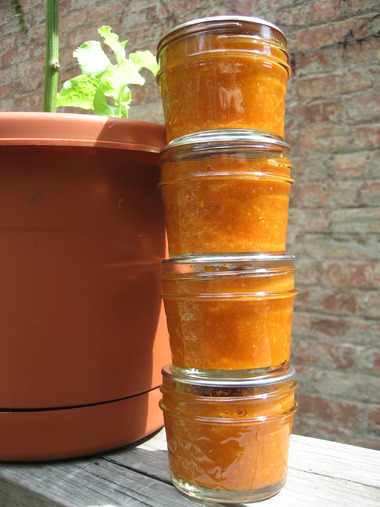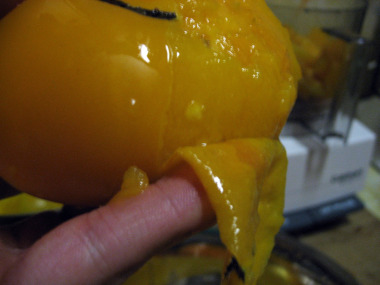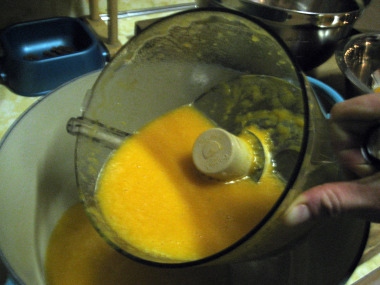I’m not going to lie; you gotta want to make ketchup. I see it like Mr. Izzard’s description of certain career paths:
Not to liken ketchup-makery exactly to the life path and career choices of taxidermists or beekeepers, but I’m just sayin’ it’s not an “oh, whatever” kind of thing. There’s some work involved.
It’s totally worth it though. After we made a standard red ketchup at our Canvolution party a couple weekends ago (and I proceeded to spoon my portion right out of the jar) I was hooked on homemade ketchup. When orange heirlooms appeared last week in our CSA (farmshare), I figured why not shake things up in my limited ketchup experience.
Julia, our August hostess, granted me a new ninja name, Small-batch Kickass. I gleefully accept.
In line with my reduction-ist history, I made do with what I got from the CSA and added a few extra heirlooms from my co-op to make about half of what the recipe calls for.
Orange Tang Ketchup
Reduced and modified (slightly) from Linda’s Hot Orange Ketchup recipe in The Joy of Pickling
yield four sealed quarter-pint jars plus some change in a half pint fridge jar
 CSA ‘maters; beauty-queen cherries thrown in for visuals (not used in ketchup)1. Prepare your tomatoes for the puree process. I started with:
CSA ‘maters; beauty-queen cherries thrown in for visuals (not used in ketchup)1. Prepare your tomatoes for the puree process. I started with:
3lbs 6oz whole tomatoes
Slice an ‘X’ into the bottoms with a steak or paring knife.
2. Bring a pot of water (I used a 6-quart pot) to a full boil and then dip your X-marked tomatoes into the water for about 20 seconds. This helps loosen their skins so you can peel them easily. Peel carefully since they’ll be hot. Peeling tomatoes is cathartic after a long day at the computer.3. Core the tomatoes (aka remove the hard, middle portion of the tomato where it was attached to the vine).
Peeling tomatoes is cathartic after a long day at the computer.3. Core the tomatoes (aka remove the hard, middle portion of the tomato where it was attached to the vine).
4. I don’t have either of the tools Linda says are helpful (a food mill or Vita-Mix) for tomato pureeing, so I had to get crafty. (Please read the section in her book about the best way to prepare tomato puree should you happen to have either of these cool tools.) Here’s my improvised food processor method that worked out just dandy:
Chop the skinned tomato into a few large chunks and toss them into a food processor; I did it in two batches. Also, I’m a seeds-in kind of girl, but I bet you could strain most out using a mesh strainer as you pour the puree into the cooking pot.
Pour puree directly into a large, heavy-bottomed stainless steel or enameled cast-iron pot. I ended up with about 5 cups of tomato puree.
5. Prepare rest of veggies and throw them directly into the tomato puree pot:

- 4 or 5 assorted hot peppers, seeded and chopped (I used two of the yellow ones above and each of the other varieties) [You might consider gloves for this task, I’ve made one too many enchilada sauces to do it bare handed any longer]
- half of a medium-sized yellow onion, chopped (or 5 oz if you’re weighing it out)
- 7 garlic cloves, chopped
Simmer tomato puree and veggies for 15-20 min, until the veggies are tender.
6. While tomato and veg puree is simmering, prepare spice bag (or use kitchen twine to tie a scrap of cheesecloth around the following):
- 1 lemon zested in strips
- 1.5 tsp mustard seeds
- 1.5 tsp coriander seeds
- 5 whole cloves
- cinnamon stick broken into a few pieces
- 2 thin slices of fresh ginger
Set aside.
7. When veggies are tender, remove tomato puree and veg mixture from heat. Ladle out cupfuls of the mixture into your food processor (or blender) until you hit the ‘liquid fill line’ marked on most processor bowls. Trust me, you’re going to want to do this in shifts (or you’ll shoot pureed tomato juice and bits around the kitchen). I did it in three batches.
8. Return the new and improved puree to the pot and add:
the juice from your zested lemon, strained
3/4 cup white wine vinegar (I didn’t plan well, so I added 1/2 cup cider vinegar to my measly 1/4 cup, bottom-of-the-bottle white wine vinegar)
1.5 tsp pickling (or 2 tsp Kosher) salt
spice bag you prepared above
9. Simmer ketchup until it thickens up. The smaller the batch, the faster it will thicken. Mine took about a half hour, but my burner was up too high in the beginning (oops). Low and slow is the general rule for thickening. Stir occasionally to incorporate all portions of the mixture and keep bottom from scorching.
10. Remove spicebag and ladle hot ketchup into hot jars leaving 1/4” headspace and seal with two-piece lids. Process for 15 minutes in a waterbath.
Alternatively you could stash it in the fridge if you’ve had enough of the stovetop for the evening. It’s high in vinegar and should keep fine for a few months.
Aaaaand the taste…It’s not hot, by any means. There’s no sugar in it, so it won’t taste like your standard ketchup, but this tangy condiment adds a tasty vinegary zest to whatever you dare dollop.
